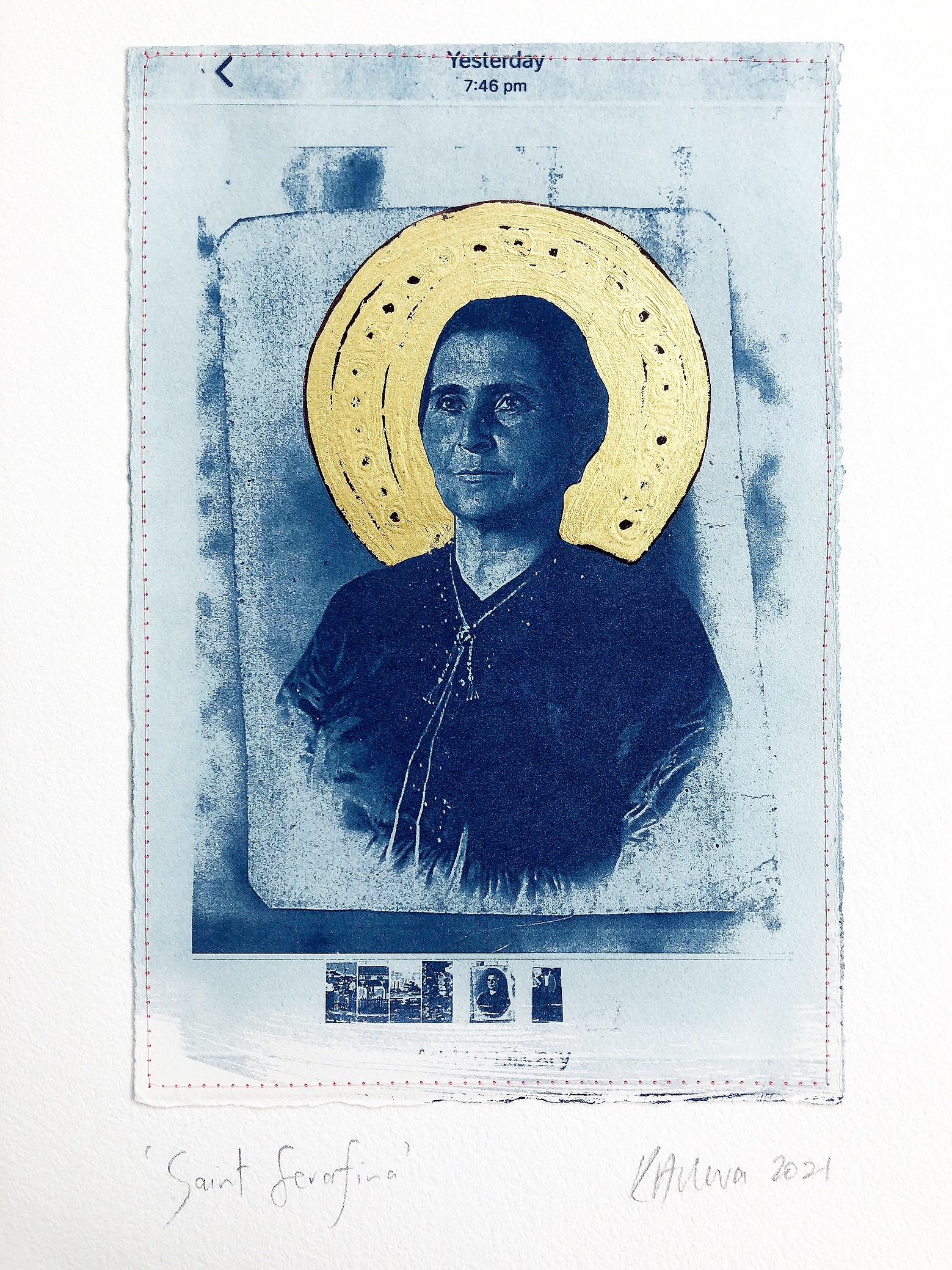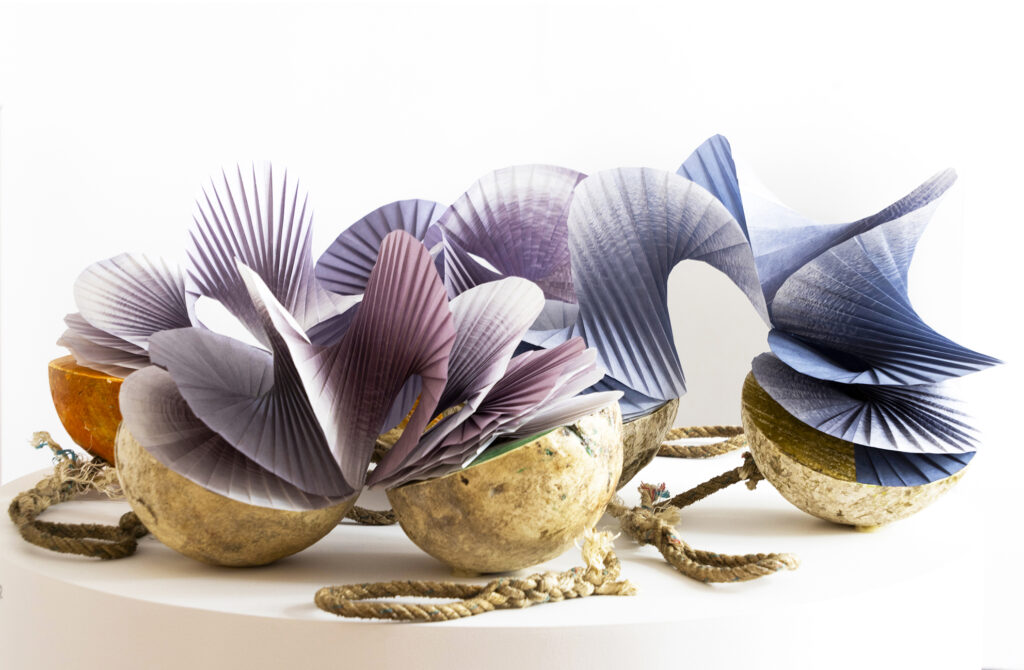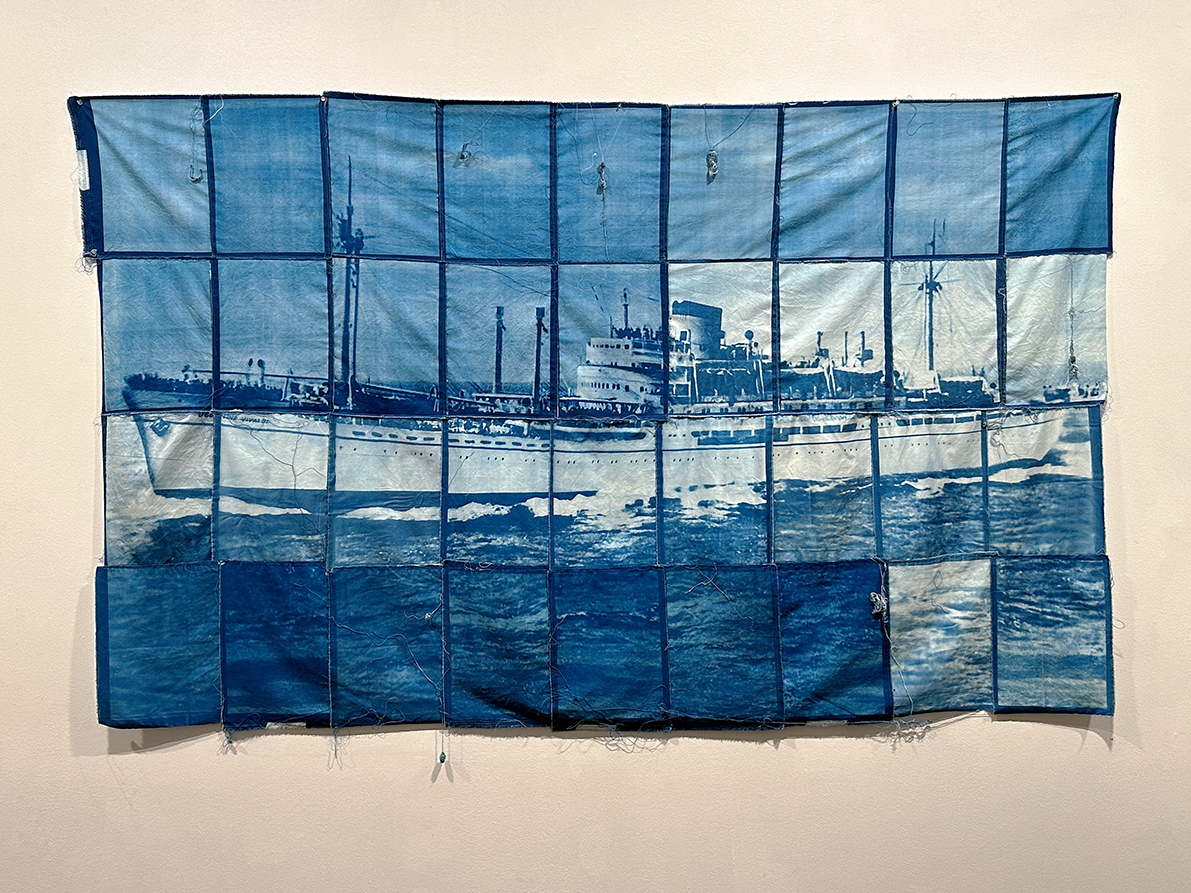
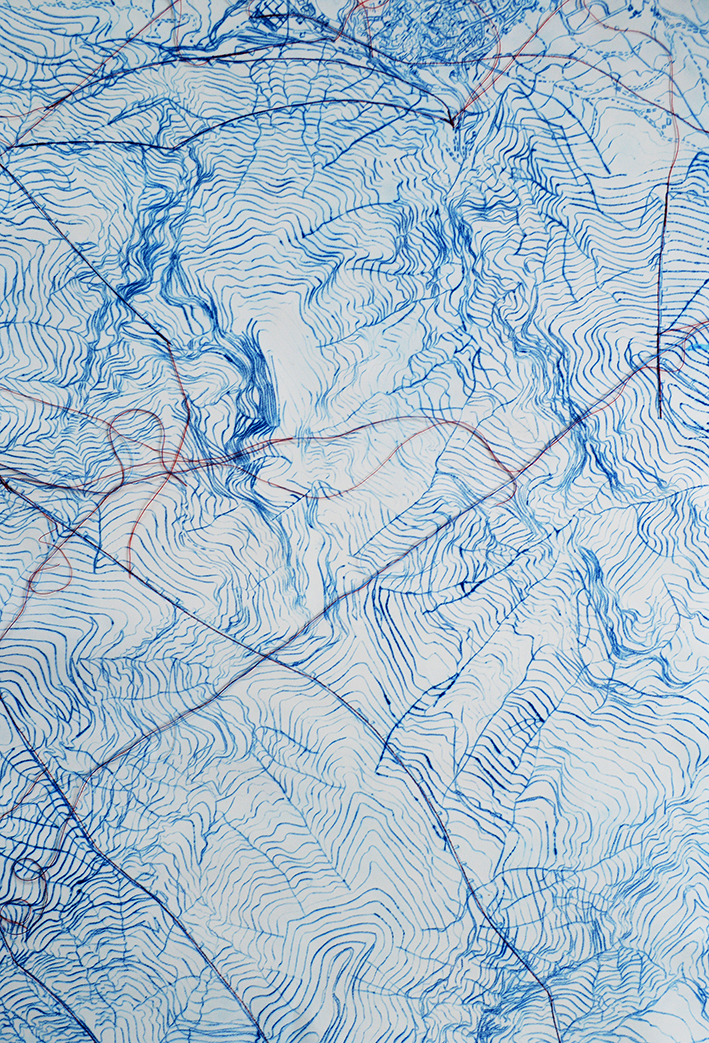
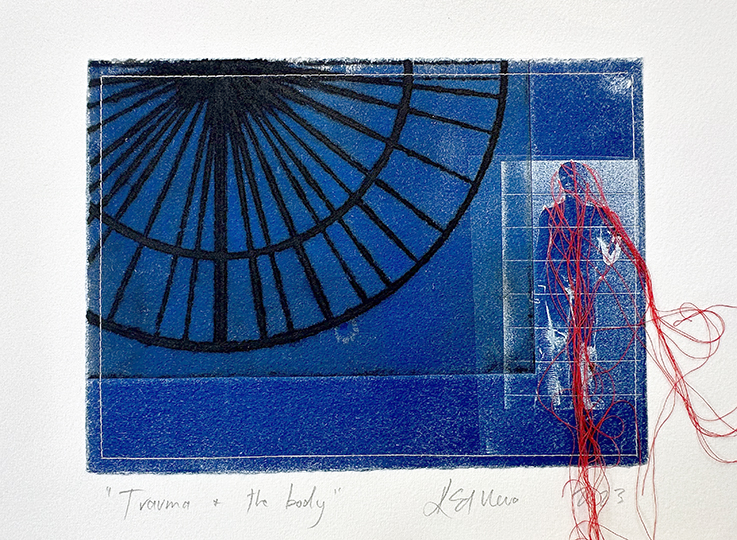
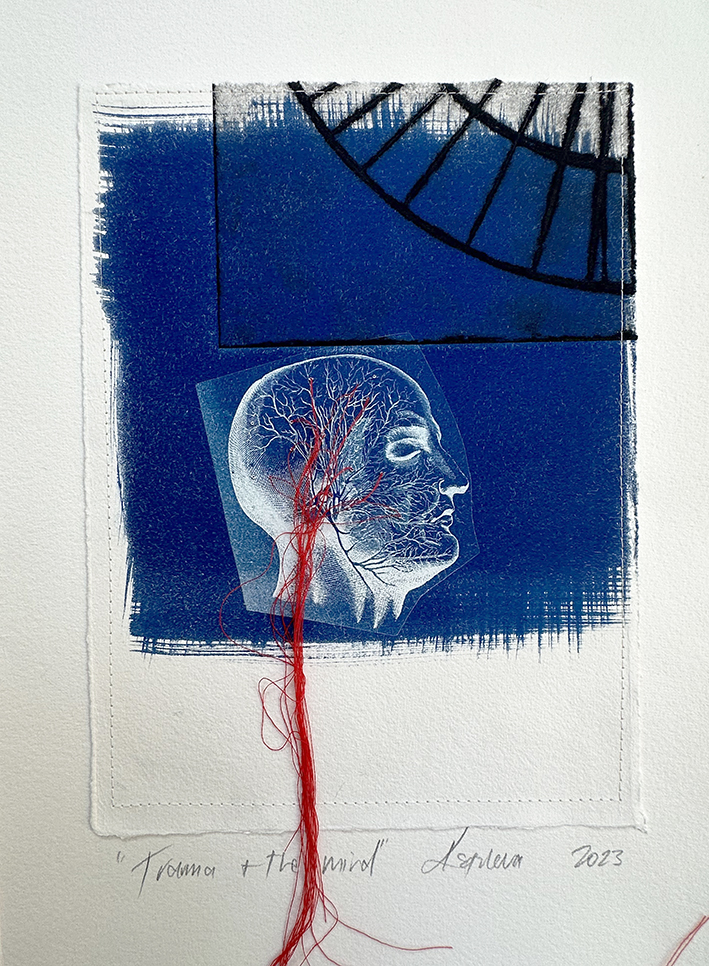
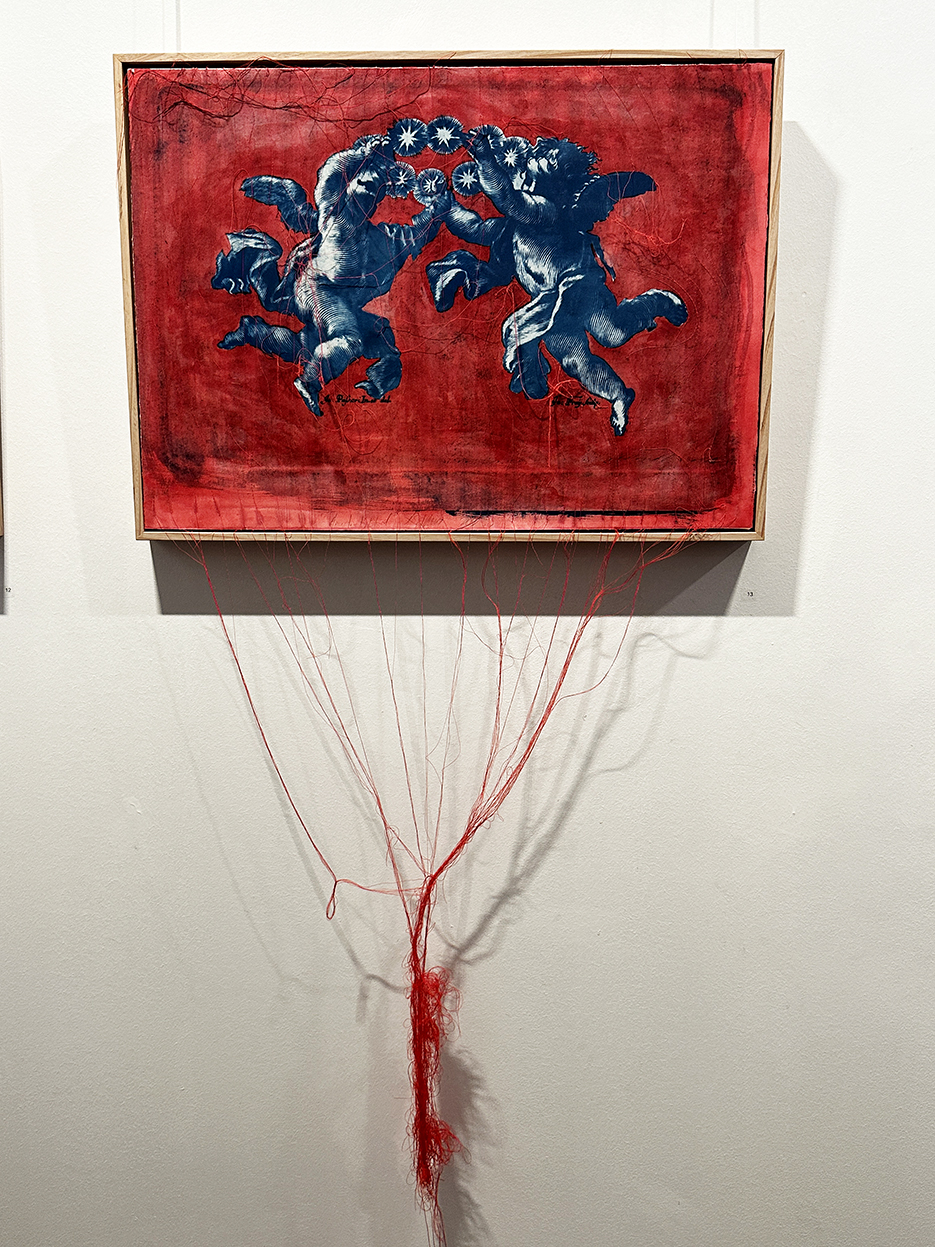
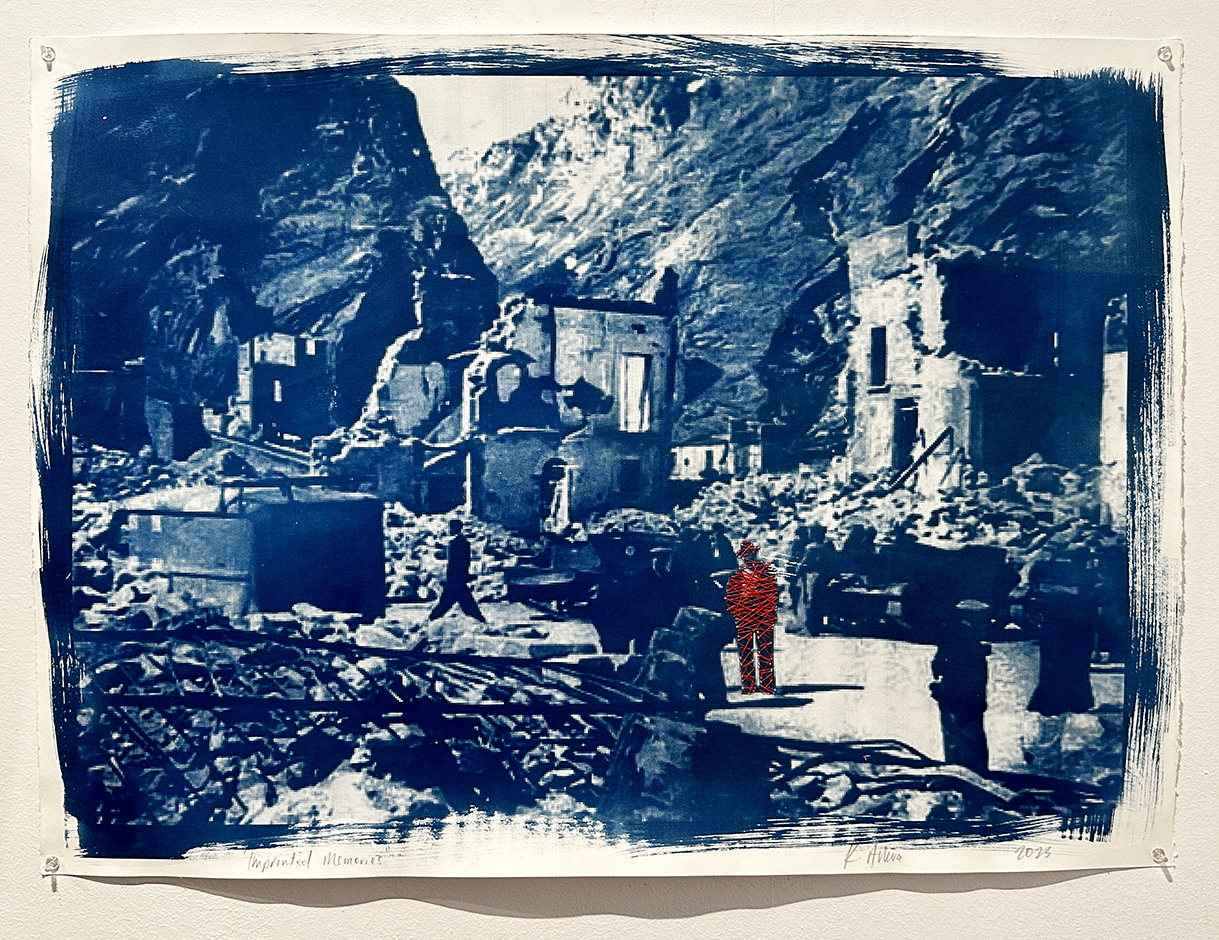

From top:
Katie Alleva (all images courtesy of the artist):
Saint Serafina, 2021, cyanotype, stitch, ink, 24K gold leaf on paper, Renaissance wax, 37 x 51.5 cm.
Ugolino Vivaldi, 2023, cyanotype on cotton sateen, collage, stitching, 148.5 x 1.89 m.
Topographical search -The Majella mountains and Fara San Martino, 2023, drypoint, red stitching, Renaissance wax, oak frame, 50 x 70 cm.
Topographical search -The Majella mountains and Fara San Martino, 2023, drypoint, red stitching, Renaissance wax, oak frame, 50 x 70 cm.
Trauma in the body, 2023, cyanotype, drypoint, hand stitching, Renaissance wax, 26 x 39 cm.
Trauma in the mind, 2023, cyanotype, drypoint, hand stitching, Renaissance wax, 26 x 39 cm.
Ancestral Blood, 2023, cyanotype, ink, stitching, Renaissance wax, oak frame. 75.5 x 56.5 cm.
Imprinted Memories, 2023, cyanotype, hand stitching on paper, Renaissance wax, 50 x 70 cm.
Q: What were some of the foundation ideas for this exhibition project?
A: I became interested in knowing more about my ancestors after my father shared a photo of my great-grandmother Serafina. I started asking many questions about her and inevitably became a detective obsessed with finding out more about her and her husband, Luigi Alleva. I learned she lost 10 or 11 children, her husband migrated to Australia in 1927 to find work, they never saw each other again, and her only son was conscripted to fight in World War II. I thought that was a lot of trauma to go through. Her son walked back from Albania after the war stopped to discover Serafina had died of gangrene and the house and village had been bombed by the Germans. I was diagnosed with PTSD in 2018 and I started thinking, why and how did I end up with this diagnosis? I began to research intergenerational trauma and investigated its impact on offspring and third-generation children. I wanted to understand if what happened in the past had any impact on my diagnosis. I wanted to reflect on this question through a creative project and Tracing threads: through the emotional landscape of self, is the outcome of that inquiry.
Q: How did the artwork selection take place?
A: I began talking a lot to my Italian father Gino. We would video call and go through his archives of inherited black-and-white photographs. My father gave me an old camera that was his father’s. That is when I realised my Italian Poppa was quite the photographer. A lot of the family images were taken by him as he wasn’t in the frame. It was clear that whoever took the photos had a love of photography. Having studied photography myself, I felt an instant connection to these photographs and could see these were one of the ways I could get to know my ancestors. My father texted me so many photos, he would get together with his brother Rico and they would scan them and email me. My Aunty Sera also helped and sent me a box of Alleva archives. I spent hours and hours sifting through each photograph, object, and document. I realised I had a lot to work with, so the most difficult part was to distil the imagery. I decided to visually capture a narrative of the Alleva family pre-migration to and post-migration to Australia. I focused on piecing the story together through visual imagery from the Alleva archives, immigration archives found in the Australian National Archives, photographs of the German invasion of Italy, and the reclaiming of Italy by America and other countries from the Smithsonian archive.
Q: How does the exhibition manifest – what do visitors experience?
A: The exhibition is a personal story about ancestral loss and trauma. Hopefully, visitors will connect with their own questions and thoughts about their own ancestors. Visitors may find the exhibition moving and experience an emotional reaction. The show demonstrates what families go through when there is serious conflict in their lives, specifically, it reflects on the impact of war and conflict. There are connections to the war in Ukraine. That this topic is unfortunately still relevant today makes us stop and think about humanity and how precious life is. It also asks us to honour our ancestors and acknowledge the hardships they endured. It may spark a quest for the audience to begin to ask questions about their own ancestral past.
Q: What are some of the key works and what subject matter do they deal with?
A: The key words are Ugolino Vivaldi, an alternative photographic textile work, of the ship my family, came over to Australia on. When I first saw the image, I heard sounds. It was profound. I heard the foghorn of the ship, Italian people chatting, waves, and wind. I decided to create a multi-media projection called, Across the emotional landscape of self. I knew the sound was the only way I could convey my ancestor’s experience and my reaction to viewing this image. I worked with a sound designer, and she worked with me to recreate this.
The other significant works are Trauma in the mind and Trauma in the body. I combine dry point with stitch and cyanotype. The black dry point wheel print detail represents the continuing cycle of intergenerational trauma. I also use dry point to investigate the topographical region in Italy where my ancestors are from. It’s a tiny village called Fara San Martino backed right onto the Majella mountains. I stitched into the print with red thread to convey the trauma lines. These represent the lost culture, lost land, and dislocation.
Q: What is it about the printmaking experience that you most appreciate?
A: Most of the artworks are cyanotypes. As a teacher of printmaking and a lover of printmaking, I am claiming cyanotypes are part of the printmaking visual vocabulary! They are less expensive to make than solar etchings and are like the process of solar etching. I loved making negatives and exposing them on paper using the sun. I love how instant they are. The process is akin to hanging the washing out. You need to wash the print and hang the printout to dry. In my next body of work, however, I do plan to work with solar etching.
Drypoint allowed me to slow down and connect with my ancestral home, Fara San Martino and the Majella Mountains, and feel connected to it. The process was a chance to reconcile all the unresolved emotional frustration I had as a teenager wondering why we didn’t have more Italian culture in our lives and the feeling I was Italian but couldn’t speak the language or even communicate properly with my grandparents. I felt a great loss growing up. Printmaking and alternative photography allow me to connect to these emotions.
I love the nature of the handmade. Of pulling the print myself. Printmaking offers an incredible textural quality on paper. My true love is peeling back the print!
—
Tracing threads – across emotional landscapes of self, is at the Northern Rivers Community Gallery, Ballina, until 30 April. www.nrcgballina.com.au
Q & A with Katie Alleva: 27 April, 5pm.
Botanical Impressions with Wet Cyanotype Photograms workshop 15 April 10am, $130.
—
Join the PCA and become a member. You’ll get the fine-art quarterly print magazine Imprint, free promotion of your exhibitions, discounts on art materials and a range of other exclusive benefits.

